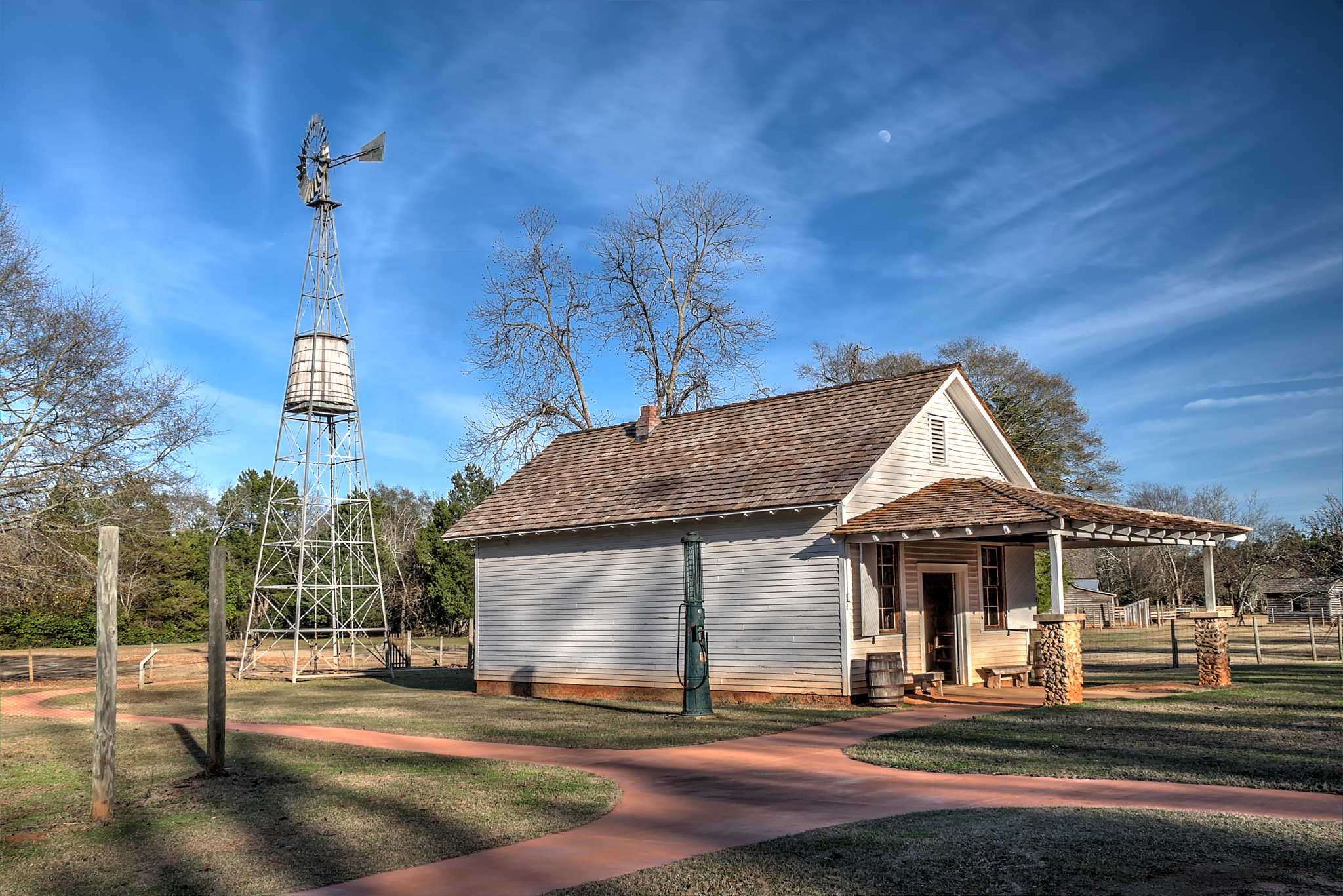|
Georgia Historical Commission
The Georgia Historical Commission was an organization created by the U.S. state of Georgia for purposes of historic preservation. The Georgia legislature created it in February 1951 to promote and increase knowledge and understanding of the history of Georgia. Its work, including the erection of hundreds of historical markers, was accomplished during a relatively brief existence. These markers are still standing today. The impetus for the creation of the commission came from several sources as local historical societies were launching restoration projects of statewide importance. These projects often needed not only financial and technical help but a way to coordinate plans with other state projects. Three Atlanta civic leaders lobbied for a state historical commission: Henry A. Alexander, an attorney who was appointed chairman of the first board of commissioners; Joseph Jacobs, a pharmacist; and Frank Boland, a physician who wanted a memorial for Crawford W. Long, a Georgian ... [...More Info...] [...Related Items...] OR: [Wikipedia] [Google] [Baidu] |
The Atlanta Journal-Constitution
''The Atlanta Journal-Constitution'' is the only major daily newspaper in the metropolitan area of Atlanta, Georgia. It is the flagship publication of Cox Enterprises. The ''Atlanta Journal-Constitution'' is the result of the merger between ''The Atlanta Journal'' and ''The Atlanta Constitution''. The two staffs were combined in 1982. Separate publication of the morning ''Constitution'' and the afternoon ''Journal'' ended in 2001 in favor of a single morning paper under the ''Journal-Constitution'' name. The ''Atlanta Journal-Constitution'' has its headquarters in the Atlanta suburb of Dunwoody, Georgia. It was formerly co-owned with television flagship WSB-TV and six radio stations, which are located separately in midtown Atlanta; the newspaper remained part of Cox Enterprises, while WSB became part of an independent Cox Media Group. ''The Atlanta Journal'' ''The Atlanta Journal'' was established in 1883. Founder E. F. Hoge sold the paper to Atlanta lawyer Hoke Smith in 1 ... [...More Info...] [...Related Items...] OR: [Wikipedia] [Google] [Baidu] |
Historical Markers In The United States
History (derived ) is the systematic study and the documentation of the human activity. The time period of event before the invention of writing systems is considered prehistory. "History" is an umbrella term comprising past events as well as the memory, discovery, collection, organization, presentation, and interpretation of these events. Historians seek knowledge of the past using historical sources such as written documents, oral accounts, art and material artifacts, and ecological markers. History is not complete and still has debatable mysteries. History is also an academic discipline which uses narrative to describe, examine, question, and analyze past events, and investigate their patterns of cause and effect. Historians often debate which narrative best explains an event, as well as the significance of different causes and effects. Historians also debate the nature of history as an end in itself, as well as its usefulness to give perspective on the problems of the ... [...More Info...] [...Related Items...] OR: [Wikipedia] [Google] [Baidu] |
Georgia Historical Quarterly
The Georgia Historical Society (GHS) is a statewide historical society in Georgia. Headquartered in Savannah, Georgia, GHS is one of the oldest historical organizations in the United States. Since 1839, the society has collected, examined, and taught Georgia history through a variety of educational outreach programs, publications, and research services. History Founded in 1839 in Savannah, Georgia, the Society is the oldest continuously operating state historical society in the Southern United States and one of the oldest historical organizations in the United States. Founders include John Macpherson Berrien, Richard D. Arnold, Eugenius A. Nisbet, Thomas Butler King, William Bacon Stevens, Israel K. Tefft, James Hamilton Couper, Edward Padelford, Mordecai Myers, Alexander Smets and James Moore Wayne. Mission statement The Georgia Historical Society is an independent statewide institution responsible for collecting, examining, and teaching Georgia history. Facilities Ge ... [...More Info...] [...Related Items...] OR: [Wikipedia] [Google] [Baidu] |
Georgia Historical Society
The Georgia Historical Society (GHS) is a statewide historical society in Georgia. Headquartered in Savannah, Georgia, GHS is one of the oldest historical organizations in the United States. Since 1839, the society has collected, examined, and taught Georgia history through a variety of educational outreach programs, publications, and research services. History Founded in 1839 in Savannah, Georgia, the Society is the oldest continuously operating state historical society in the Southern United States and one of the oldest historical organizations in the United States. Founders include John Macpherson Berrien, Richard D. Arnold, Eugenius A. Nisbet, Thomas Butler King, William Bacon Stevens, Israel K. Tefft, James Hamilton Couper, Edward Padelford, Mordecai Myers, Alexander Smets and James Moore Wayne. Mission statement The Georgia Historical Society is an independent statewide institution responsible for collecting, examining, and teaching Georgia history. Facilities Geo ... [...More Info...] [...Related Items...] OR: [Wikipedia] [Google] [Baidu] |
Georgia Department Of Natural Resources
The Georgia Department of Natural Resources (DNR) is an administrative agency of the U.S. state of Georgia. The agency has statewide responsibilities for managing and conserving Georgia’s natural, cultural, and historical resources, and has five divisions: *Coastal Resources *Environmental Protection *Law Enforcement * Parks, Recreation & Historic Sites *Wildlife Resources The DNR is headed by a commissioner, currently Mark Williams. The department's Board of Natural Resources is composed of 18 citizens who oversee rulemaking for the agency. Members are appointed by the governor and approved by the state senate. The Historic Preservation Division was transferred from the DNR to the Department of Community Affairs in 2020. Mission The mission of the Georgia Department of Natural Resources is to sustain, enhance, protect and conserve Georgia’s natural, historic and cultural resources for present and future generations, while recognizing the importance of promoting the develo ... [...More Info...] [...Related Items...] OR: [Wikipedia] [Google] [Baidu] |
Jimmy Carter
James Earl Carter Jr. (born October 1, 1924) is an American politician who served as the 39th president of the United States from 1977 to 1981. A member of the Democratic Party (United States), Democratic Party, he previously served as the 76th governor of Georgia from 1971 to 1975 and as a Georgia state senator from 1963 to 1967. Since leaving office, Carter has remained engaged in political and social projects, receiving the Nobel Peace Prize in 2002 for his humanitarian work. Born and raised in Plains, Georgia, Carter graduated from the United States Naval Academy in 1946 with a Bachelor of Science degree and joined the United States Navy, serving on numerous submarines. After the death of his father in 1953, he left his naval career and returned home to Plains, where he assumed control of his family's peanut-growing business. He inherited little, due to his father's forgiveness of debts and the division of the estate amongst himself and his siblings. Nevertheless, his ... [...More Info...] [...Related Items...] OR: [Wikipedia] [Google] [Baidu] |
National Register Of Historic Places
The National Register of Historic Places (NRHP) is the United States federal government's official list of districts, sites, buildings, structures and objects deemed worthy of preservation for their historical significance or "great artistic value". A property listed in the National Register, or located within a National Register Historic District, may qualify for tax incentives derived from the total value of expenses incurred in preserving the property. The passage of the National Historic Preservation Act (NHPA) in 1966 established the National Register and the process for adding properties to it. Of the more than one and a half million properties on the National Register, 95,000 are listed individually. The remainder are contributing resources within historic districts. For most of its history, the National Register has been administered by the National Park Service (NPS), an agency within the U.S. Department of the Interior. Its goals are to help property owners and inte ... [...More Info...] [...Related Items...] OR: [Wikipedia] [Google] [Baidu] |
American Civil War
The American Civil War (April 12, 1861 – May 26, 1865; also known by other names) was a civil war in the United States. It was fought between the Union ("the North") and the Confederacy ("the South"), the latter formed by states that had seceded. The central cause of the war was the dispute over whether slavery would be permitted to expand into the western territories, leading to more slave states, or be prevented from doing so, which was widely believed would place slavery on a course of ultimate extinction. Decades of political controversy over slavery were brought to a head by the victory in the 1860 U.S. presidential election of Abraham Lincoln, who opposed slavery's expansion into the west. An initial seven southern slave states responded to Lincoln's victory by seceding from the United States and, in 1861, forming the Confederacy. The Confederacy seized U.S. forts and other federal assets within their borders. Led by Confederate President Jefferson Davis, ... [...More Info...] [...Related Items...] OR: [Wikipedia] [Google] [Baidu] |
Historical Marker
A commemorative plaque, or simply plaque, or in other places referred to as a historical marker, historic marker, or historic plaque, is a plate of metal, ceramic, stone, wood, or other material, typically attached to a wall, stone, or other vertical surface, and bearing text or an image in relief, or both, to commemorate one or more persons, an event, a former use of the place, or some other thing. Many modern plaques and markers are used to associate the location where the plaque or marker is installed with the person, event, or item commemorated as a place worthy of visit. A monumental plaque or tablet commemorating a deceased person or persons, can be a simple form of church monument. Most modern plaques affixed in this way are commemorative of something, but this is not always the case, and there are purely religious plaques, or those signifying ownership or affiliation of some sort. A plaquette is a small plaque, but in English, unlike many European languages, the term ... [...More Info...] [...Related Items...] OR: [Wikipedia] [Google] [Baidu] |
Chief Vann House Historic Site
The Chief Vann House is the first brick residence in the Cherokee Nation, and has been called the "Showplace of the Cherokee Nation". Owned by the Cherokee Chief James Vann, the Vann House is a Georgia Historic Site on the National Register of Historic Places and one of the oldest remaining structures in the northern third of the state of Georgia. It is located in Murray County, on the outskirts of Chatsworth in northwest Georgia, which has a commanding view of the land around it and of the Cohutta Mountains, about to the east. Construction of the Vann House When James Vann was rising to become the wealthiest businessman and chief in the Cherokee Nation, he decided to build a two-story brick house which would reflect his status. He brought in professional architects for its design. In addition to providing an education to local Cherokees, the Moravians contributed to the building. In July 1803, a man named Vogt (perhaps James Vann's brother-in-law Charles Vogt), and Dr ... [...More Info...] [...Related Items...] OR: [Wikipedia] [Google] [Baidu] |
Museum
A museum ( ; plural museums or, rarely, musea) is a building or institution that cares for and displays a collection of artifacts and other objects of artistic, cultural, historical, or scientific importance. Many public museums make these items available for public viewing through exhibits that may be permanent or temporary. The largest museums are located in major cities throughout the world, while thousands of local museums exist in smaller cities, towns, and rural areas. Museums have varying aims, ranging from the conservation and documentation of their collection, serving researchers and specialists, to catering to the general public. The goal of serving researchers is not only scientific, but intended to serve the general public. There are many types of museums, including art museums, natural history museums, science museums, war museums, and children's museums. According to the International Council of Museums (ICOM), there are more than 55,000 museums in 202 countrie ... [...More Info...] [...Related Items...] OR: [Wikipedia] [Google] [Baidu] |
.jpg)




